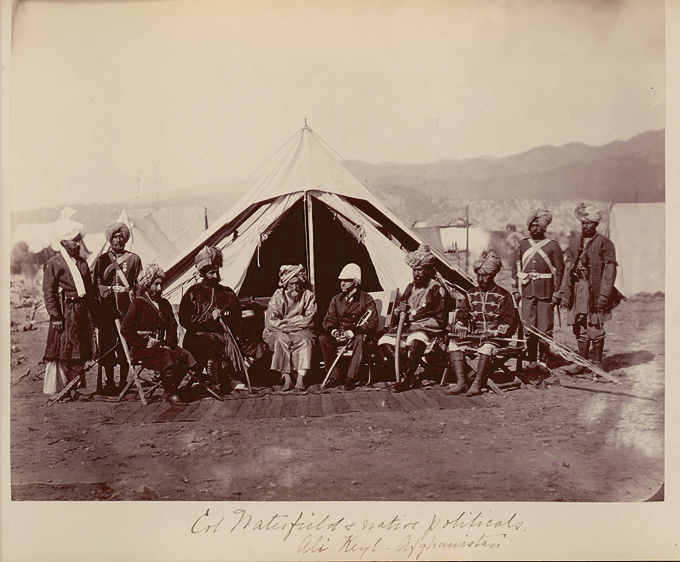Primitive Skin Cloaks from the Stone Age - Posteen and Horse Rustlers
 B. Simpson photographed Colonel Waterfield and his men in Kurum Valley near "Peiwar Valley" Afghanistan in 1878. A Ghilzai Pashtun, wearing a Posteen was recorded standing to the left of the group. Patterned cloth has been used on the outside of the Posteen with the sheepskin lining showing.
B. Simpson photographed Colonel Waterfield and his men in Kurum Valley near "Peiwar Valley" Afghanistan in 1878. A Ghilzai Pashtun, wearing a Posteen was recorded standing to the left of the group. Patterned cloth has been used on the outside of the Posteen with the sheepskin lining showing.
When the images of the "Kakur" and "Afghan Horse Dealers" were posted on this blog there were a few questions asked.
"Maybe they're horse rustlers?" Milton Cater
"Our friends in the second image came directly from the “come as you are” party. I somehow trust them more, although they do look like they might be pickpockets, they aren’t pretending otherwise." Monika Neuland Kimrey
Searching high and low I discovered the original notes which accompanied these images published in "The People of India" between 1865 and 1875. The photographers were H.C.B Tanner (Henry Charles Baskerville) and Captian William Robert Houghton. The government of India had commissioned the work and the eight volume set of albums is noted as "being one of the first major ethnographic studies produced by the camera."
Notes accompanying the image "A Kakur Afghan" describe the cloak as "Afghan winter costume, a posteen, or cloth cloak, lined with sheeps' wool, forming a most comfortable wrapper." Posteen is consistent with other similar words used to describe sheep skin bedding rugs like "postak".


Readers of this blog instantly detected the true character of the horse dealers. The following description was given to these dogged traders in "The People of India". "The independence of character which seems to belong to these persons is, perhaps, not a very sound principle or feeling. The love of money would lead them to sacrifice honour or honesty on most occasions where unlawful gains were obtained with impunity."


The link between pieced skin rugs, Postak, Pashmani and Posteen cloaks indicates that the practice of using animal hides including sheep skin was common in Afghanistan. From primitive beginnings the wearing of animal skins continued in Central Asian culture throughout the ages, being refined into a patterned and lined cloak, warm and comfortable in the winter, donned by aristocrats and horse rustlers alike. A true Afghan winter "costume".
IMAGES:
Col Waterfield in Uniform and with Sword; And Group of Men in Costume with Sabers and Rifles Outside Tent OCT 1878
DOE Asia: Afghanistan: NM 40922 04420300, National Anthropological Archives, Smithsonian Institution, Simpson B. Bourne and Shepherd 1878. Afghanistan Kurum Valley/Peiwar Valley (Near)
Images contained within the collection: The People of India, Freer Gallery of Art and Arthur M. Sackler Gallery Archives. Smithsonian Institution, Washington, D.C. “A Kakur” Local number: PoI6.322 “Afghan Horse Dealers” Local number: PoI6.332 H.C.B Tanner (Henry Charles Baskerville) and Captian William Robert Houghton







